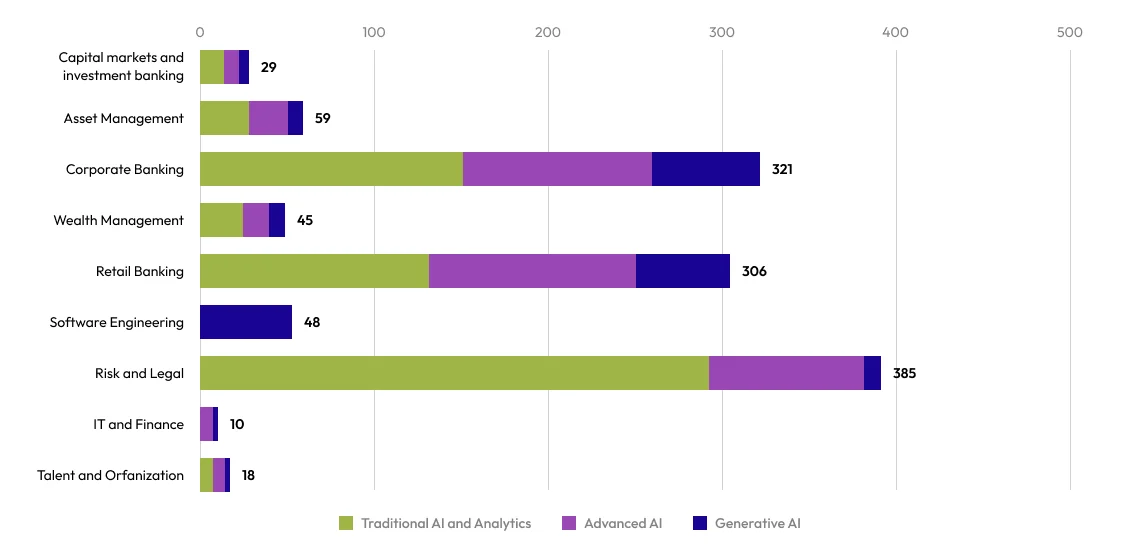AI in Banking: Revolutionizing the Future of Finance
- AI/ML
- June 14, 2024
Wouldn’t it be great if banks were available round the clock, offering personalized and automated services? Yes, appealing! Well, that can be done by taking a pivotal step towards utilizing AI in banking and finance operations that combines personalization, automation, and risk management. But how to do that appropriately? This blog is at your disposal, covering everything you need to know about AI in banking and finance.
Gone are the days when we had to take a day off to call it a bank day and visit it to complete the formalities with the banks for specific objectives. Not just us as customers of the bank, but employees of the bank also have to go through tons of paperwork and apply many logical-mathematical and statistical expressions for certain financial calculations.
There’s one deep thought that Bill Gates once shared, “The world needs banking, but it does not need banks!” It means what if banks are accessible to users 24/7 and always available to offer us personalized financial advice or information whenever and wherever we need it?
It was all just an idea until Industry 4.0, especially with the possibilities of AI in banking, got the impression. It has revolutionized the way Banking, Financial Services and Insurance (BFSI) Industries do respective operations.
For global banking, McKinsey estimates that AI technologies could potentially deliver up to $1 trillion of additional value each year.
With the potential of AI and Machine Learning Models (especially LLMs), the banking sector is likely to see the positive impact of AI, especially Generative AI with area-specific applications.
Some of the popular automation of labor-intensive tasks like customer support, data entry and computation, etc. Another is an augmentation of various aspects of banking operations, like credit score analysis, data preparation for personalization, risk assessment and fraud detection, and more, with the help of generative AI. By leveraging generative AI, banks can enhance decision-making processes, streamline operations, and offer more tailored customer experiences.
| BFSI Areas | Automation | Augmentation |
| Banking | 39% | 34% |
| Insurance | 33% | 37% |
| Capital Market | 32% | 37% |
But how AI is taking its shape in the banking sector? Well, this blog covers everything you should know about the wonders of AI in banking.
The Market Scenario of AI in Banking and Finance
Given the amount of financial data and computations banks have to deal with on a daily basis and manage all, while considering industry compliances and best practices, it’s hard to disapprove that this sector is one of the most R&D Intensive with AI/ML and Deep Learning technologies.
Of course, various factors that drove the attention of banks towards AI, include fraud prevention, better risk management, personalized and improved customer service experiences, and most importantly offerings like better efficiency leading to profit growth.
Since the digital transformation in banking operations has made banks focus more on the development of skill sets, approaches, and mindsets, this emphasis applies to every functional level of the bank
If analyzing the top banks globally, Lloyds Banking Group and Banco Santander are stacking up their investment to make their organization tech-savvy by partnering with IT companies for AI/ML development services. They are hiring dedicated AI developers actively to work on their AI mission.
Accenture’s 2022 Future of Work, survey revealed that only 26% of bank CEOs have a future-ready strategy. Speaking of which, Generative AI has gained popularity in the banking sector.
As generative AI is the subject, its early adopter Singapore’s OCBC Bank has successfully tested an intelligent chatbot for its operations and efficiency requirements. After getting assurance on its compatibility with its banking operations, now it is making this Generative AI-powered chatbot for its 30,000 employees to reap its potential for their writing, translation, research, and innovation tasks. Based on their experience working with these advanced chatbots, they shared that it has resulted in a positive helping them deliver their tasks 50% faster than usual with utmost accuracy.
After testing the potential of a Generative AI chatbot for banking for their code development, document summarization, call transcription, and other knowledge base requirements, they use it to make 4M+ decisions daily in the segments of risk management, customer services, and sales. Based on their experience with this solution’s exceptional help, they are expecting to scale their dependency on decision-making for the same may increase to 10 million by 2025.
Lastly, in a 2023 survey conducted on 5,000+ C-level executives, reveals that 95% agree with Generative AI leading the enterprise intelligence landscape amongst other AI trends in Banking.
What are the Advantages of AI Banking?
It is not surprising that AI is benefiting the banking and finance sector to the advanced level with its emerging use cases for the same. If we talk about the popular AI elements and applications like machine learning, natural language processing, and computer vision, they can significantly help in improving and transforming the way banking processes are done.
Want to know why? It’s quite obvious, and Martha Bennett, a principal analyst at Forrester Research, validates that financial organizations have an upper hand on benefiting from AI. The reason for this is, “AI needs lots of data, and banks have lots of data.”
Now the question is how banks can benefit from AI and which have found their success with this?
Some of the popular advantages of AI in Banking include:
- Enhanced customer services with 24/7 customer support, personalized customer interactions.
- Real-time monitoring and detection of fraudulent transactions.
- Improved risk assessment and management through predictive analytics.
- Streamlined processes leading to cost savings and reduced errors.
- Offers advanced analytics for better decision-making and strategy development.
- Improved tracking and management of regulatory changes.
- Enhanced protection against cyber threats with AI-based security systems.
- Cost efficiency with efficient resource management.
- Reduction in human errors with AI-driven processes.
But how to achieve all these benefits? Well, that requires knowledge about possible use cases of AI in banking. And the next section is all about that.
Popular Use Cases of AI in Banking
Banking and finance landscapes are the most privileged and early adopters of AI technology for their operational benefits. From digital banking to AI-powered automated ones, the banking industry has explored various use cases or you say applications. So, some of the popular applications of AI in banking include:
1. AI-powered RPA for Improved Operational Cost and Risk Management
We all enjoy interacting with humans when it comes to seeking banking information or assistance for operations, but to make this possible, we have to make some adjustments as well. It could include timeline constraints specifically.
Additionally, banks have digitized their operations to offer convenience to both customers and employees. In banks, there’s always a need for human-based processes that are paperwork-heavy. In such cases, even the slightest error may lead banks to significant cost and risk issues.
As AI is highly known for automating tasks, personalizing services, managing a lot of processes in bulk in real-time, and evolving with new data streams, having its benefits associated with cost saving is quite significant.
An AI use case named RPA software that intelligently follows and automates digital processes based on certain rules comes into play. Integrated with natural language processing, text and handwriting recognition, and other advanced AI capabilities, RPA bots can offer a wide range of intelligent processes that were time-sensitive and error-prone before.
Some of the AI-powered RPA uses in banking operations include:
- Customer Onboarding, which includes collecting and verifying customer information, conducting background checks, and populating the necessary forms and documents.
- Account Maintenance, including updating customer information, processing account closures, and managing account status changes (e.g., freezing accounts or reactivating dormant accounts).
- Credit Assessment and Underwriting, helping in analyzing applicant data, retrieving credit scores, assessing risk factors, streamlining loan approval processes, and generating credit reports.
- AI-based fraud detection in banking operations by monitoring transactions in real time, identifying suspicious patterns or anomalies, and triggering alerts for further investigation.
Moreover, JPMorgan has been using AI-powered large language models (LLMs) for streamlining payment validation, offering faster processing, and reducing false positives. This has also helped it reduce the account validation rejection rate by 15-20%. Moreover, it also leverages AI to offer customers better financial analysis – cash flow analysis to be precise upon request.
2. Generative AI-powered Chatbots for Special Attention to Customer Service
Having robust customer service in place adds value to better customer acquisition and retaining existing customers. Not just other businesses but banks should also do that. But before digital transformation in banks, customers had to make a lot of adjustments to do their banking stuff.
A few years back, this transformation was only limited to paying bills, transferring money, requesting checkbooks, quick access to bank statements/passbooks, and more. But for advanced support, they either have to visit the bank, email, or call the customer care center. This is frustrating for many!
That’s where Generative AI jumps in! If checking banking segments and functions Generative AI contributes, then it is something like as presented in the chart given below in composition with traditional AI and analytics, Advanced AI, and Generative AI:

Generative AI in banking not only provides information asked but also acts upon certain requests in a way bank representatives do.
Bank of America uses AI for managing customer inquiries. BNY Mellon – a global investment bank that uses AI-powered chatbots to automate fund transfer requests, which helped it save around $300,000 annually and offer efficient customer services.
If we check the potential of Generative AI in banking, then annually, it creates significant new value for banks, around $200-340 billion, which is around 9-15% of the total. But the condition for the same is the optimal level implementation.

3. AI for Better Compliance to Regulatory Norms with Proactive Fraud Detection
If you check globally, you’ll find banking in the heavily regulated sector. It should be, as it stores tons of sensitive financial data of users, and its even slightest misuse can make users suffer a fortune.
Regulations ensure that banks treat their customers fairly and transparently. They establish rules around issues like fair lending practices, disclosure of fees, and protection of consumer data to safeguard customers’ interests.
They often mandate strict anti-money laundering (AML) and know-your-customer (KYC) procedures to prevent illicit activities such as money laundering, terrorist financing, and fraud.
Now, the question is, where do banks lag and seek support from AI to deal with compliances and regulatory norms?
Opting for the dedicated bank regulatory compliance monitoring service can be cost-intensive and a higher liability that some banks may not find appropriate to invest in. As a solution, many prefer to implement or integrate AI virtual assistants to actively keep watch over piling up transactions and customer behaviors, do audits, and create reports for regulatory compliance while minimizing overall risks for fraud.
As we talk about compliance and regulatory reporting for the BFSI section, it means automated compliance-based monitoring tasks, KYC checks, anti-money laundering screening, flagging suspicious activities, and much more.
A well-known bank – HSBC, has leveraged AI for anti-money laundering compliance checks from Ayasdi, which helped it reduce false positives by 20%.
Not just this, Barclays – a British Universal Bank, has also integrated an AI tool into its system, which monitors merchant payment transactions in real-time to predict potential fraudulent activities and take action against them to prevent such.
4. AI for Loan and Credit Decision Making
As we all know, banks deal with tons of data and find opportunities to onboard new customers for loans, sanctioning loans to particular ones that are too risk-free for the institution, and all while following compliances. Processing all these manually may be time-consuming, and effort-intensive and ask for additional cost investment.
Not just that, the process of loan approval also includes the practice of checking credit score, history, and finding factors that the applicant is eligible for the loan. This assuring process ensures banks that they are lending credits in the safe hands, which will pay them back with agreed interest rates.
That’s where banks can rely on AI-powered systems trained on extensive and diverse datasets that can help to analyze applicant’s eligibility for the loan sanction. It can also help banks analyze their vast customer data to find prospects who may be looking for a loan to find out business opportunities.
AI systems for credit underwriting and loan approval can help banks:
- Process data faster than humans can do, speeding up the loan approval process.
- Assess borrower’s creditworthiness with greater precision, reducing the risk of errors in decision-making.
- Evaluate various risk factors associated with a loan application, providing more reliable predictions of default probability.
- Personalized loan suggestions based on individual customer profiles considering factors such as income, credit history, and spending habits.
- Handle a large volume of loan applications simultaneously, allowing banks to scale their lending operations more efficiently.
- Continuously learn from past loan decisions and feedback, improving their accuracy and effectiveness over time.
However, when using AI tools for credit assessing, loan underwriting, and approval, you must make sure that it’s trained to be unbiased, which most such tools aren’t.
That’s where MindInventory, one of our clients, has trusted us with developing their AI banking software system that would help them predict the customer churn rate and find opportunities to retain them to continue doing better finance business.
5. AI Advisory and Automated Actions for Better Investment Management
Putting money into work is the favorite subject of everyone – be it banks or financial investors. Traditionally, banks used to put their market investment data into work, analyze those, and find better investment opportunities.
Now, with AI evolution, they are also investing in developing AI solutions for market investment that not only can offer investment opportunities but also automate them to a certain degree. It should do that based on user investment patterns, ability to take risks, and budget. Implementing such an advanced AI solution in their stock investment product could help them offer a better investment experience to their customers.
Firms like Switzerland-based UBS and Netherlands-based ING have AI systems in place, which actively analyze markets to find investment opportunities and update them to their algorithmic tradition systems to automate the investment processes. This not only frees customers from the anxieties of checking stock prices and making decisions every second but also gives them extra time to do their extensive market research to improve their portfolio and build better wealth.
Bank of America uses a platform called Glass that empowers investment bankers to find market opportunities to recommend to their customers for portfolio improvement.
Moreover, many banks also develop AI-powered robo-advisors to dedicatedly guide their customers through their investment-related queries and do better portfolio management. If these AI robo-advisors are powered with generative AI and personalization, they can offer quality guidance on investment based on their investment patterns and goals.
JP Morgan has created a tool called IndexGPT – an AI-powered robot advisor that acts as users’ personalized financial investment advisor with top-notch prediction and forecasting analysis capability.

How Can Banks Strategically Integrate AI into Their Operations?
It’s great to know that you’re thinking of adopting AI evolution to optimize your banking operations. However, it’s not as easy as it seems. Banks have to analyze a lot of things, prioritize a lot, and most importantly, find the right skills to make this shift available. Let’s know more considerations to strategically integrate AI solutions into their operations.
List Down Current Banking Challenges
Whether your bank runs on a small scale or large scale – regardless of the size, each has its own set of challenges and goals to take care of. When planning to implement AI for your bank, you must evaluate your bank’s current technological capabilities, data infrastructure, areas that should be focused more, and AI readiness.
You should have a clear idea about your goals for implementing AI, which could be improving operational efficiency, enhancing customer experience, or mitigating risks.
Consult AI Experts in the Banking Sector
There are times, you know what your bank needs from AI but, yet, find it difficult to define it accurately. Then, seeking help from industry experts with knowledge about the banking landscape and digital technologies would be the best choice.
Being one of the leaders offering end-to-end AI development services, we often come across clients from the banking and finance sector who come to us with their raw idea of harnessing the power of AI for their operational benefits.
For such, we align our best business analyst with industry knowledge, who could help them in their product/solution discovery process and suggest possible technological and computational architectural combinations and AI objectives that could align well with their existing IT architecture and assist in meeting their requirements.
Develop an AI Strategy Based on Your Objectives
Taking steps towards AI into your banking application is a huge decision you’re making. As you’re doing it, you should and have to think about long-term possibilities and have your plans ready – more like enterprise-level AI strategy aligned with your institutional goals and values and in compliance with industry regulatory standards.
To do so, it asks for in-depth industry market research and institutional research to find gaps to cover with possibilities of AI in finance.
At the time of creating an AI strategy, our business analysis team will also guide you through analyzing your banking practices and policies associated with talent, data, infrastructure, and more to include AI pointers to integrate across your banking functions.
We will help you define AI use cases that add the most value to your objectives, like fraud detection, customer segmentation, personalization, or risk management.
Invest in Talent and Infrastructure
After finalizing AI use cases that you want to implement for your bank, you must start your search to hire data scientists, ML engineers, and AI developers. Each talent will bring different skill sets that will help you shape the right-fit AI solution for your product.
- Data scientists will help you with data pipelining, real-time data streaming, warehousing, synthetic data generation, data modeling, and more.
- ML engineers will help you create algorithms and scale intelligent models using data prepared by data scientists.
- AI developers can help you integrate both data science and ML solutions and build comprehensive AI solutions tailored to meet your needs.
Finding the right team is most important, which requires you to have a clear view of the type of expertise you want to be in your team, their values, and budget considerations.
Develop an AI Solution
The next step is to put your team to work and develop a customized AI solution for your banking needs. This process includes building prototypes and experimenting with features and functionalities to find the best one adding value to your banking needs.
During the prototype testing phase, banks and technical teams need to create relevant datasets to fuel algorithms to learn to act/react in a proper and accurate manner. This is an ongoing process of training and retraining AI models to deliver an intelligent solution that banks need to optimize their operations, provide a better user experience, and stand out from the competition.
Take Care of Regulatory Compliance
Developing an AI solution for the bank doesn’t complete the project, it also asks for implementing certain monitoring algorithms, data privacy and security controls, and complying with regulatory requirements.
Banks are the highly regulated sector among others, which has to follow strict financial industry standards based on countries, such as General Data Protection Regulation (GDPR), Gramm-Leach-Bliley Act (GLBA), Payment Card Industry Data Security Standard (PCI-DSS), Sarbanes-Oxley Act (SOX), International Financial Reporting Standards (IFRS), Electronic Funds Transfer Act (EFTA), and more.
Compliance with these regulations is essential for banks to maintain the integrity of financial systems, protect consumers, mitigate risks, and build trust with stakeholders. Not choosing to comply with regulations may result in legal and regulatory penalties, reputational damage, financial losses, and loss of customer trust.
With vast experience in developing banking and financial apps – be it traditional banking apps or AI-powered banking and finance solutions, we help our clients comply with their country-specific industry standards.
How MindInventory Can Assist in Implementing AI for Your Banking Operations
Indeed, AI has a great influence on the BFSI sector. If you see, as compared to advanced AI solutions, Generative AI has another level of fan following; of course, due to its capabilities to generate and react. Analysts say that has the potential to boost the productivity of banks by 22-30% and revenue by 6%. Quite compelling, right?
However, to achieve such good results, you also need to hire ML engineers and AI developers to develop your AI banking solutions of that level. To do so, you also need a team of AI/ML experts!
That’s where MindInventory comes in as your reliable partner, offering top-notch AI/ML development services to help you tailor your AI product to meet your unique needs and dominate the market competition.
Have a vision for an AI-powered Banking software solution? We’re excited to know that and help you to bring it to life. Share your idea with us today!
FAQs on AI in Banking and Finance
Though AI offers many perks in the banking operations, implementing AI/ML in banking and finance brings some set of challenges, including need for cleaning and integrating siloed, inconsistent, or incomplete data, training AI unbiasedly, maintaining AI model explainability and transparency, adhering to regulatory uncertainties, and most importantly bridging the skill gap.
AI has disrupted the way banks operate and interact with customers. Bank of America uses ML to detect fraud, JPMorgan Chase utilizes AI to automate loan application reviews, Citibank uses AI to recommend suitable investment options, HSBC utilizes AI to analyze market trends and predict potential finance risks, and many others.
While AI offers significant advantages for banking in terms of efficiency, customer experience, and innovation, it also presents challenges related to privacy, job disruption, bias, cybersecurity, and regulatory compliance. Therefore, it’s essential for banks to carefully consider the ethical, legal, and social implications of AI adoption to ensure that its benefits are maximized while its risks are mitigated.
The future of AI holds immense potential for transforming various aspects of society, economy, and technology. AI will continue to automate tasks across different banking functions with precision, aid in hyper personalized user experience, customer service, and in many other ways.
AI offers tons of benefits to the banking sector, but it has its flaws as well, which may bring many chances of risks to life. Some of the popular ones are hallucination, data security, and many others. To avoid such, banks must take care of considerations like privacy risk, regulatory expectations for fair lending, and more.
The cost to implement AI in banking operations can vary widely, typically ranging from $50,000 – $100,000 to several million dollars if it’s about full-fledged AI implementation. However, costs may vary depending on factors such as the complexity of the AI solution, the scale of implementation, integration with existing systems, and ongoing maintenance and support costs.













